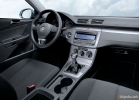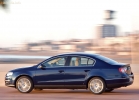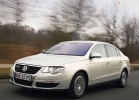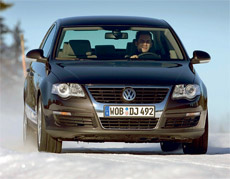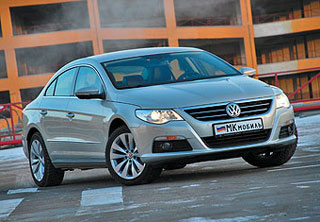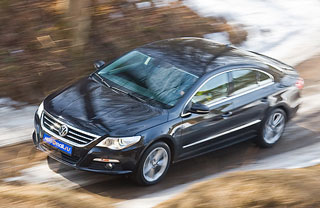Test drive Volkswagen Passat B6 2005 - 2010 sedan
Passat mixes cards
The creators of the new VW Passat were at risk. They abandoned the style under the conditional name traditional German quality and tried to combine an unlucking classic with a provocative modern one. It is not just about a new appearance. The machine has become different from a technical point of view.Having debuted in 1973, Volkswagen Passat immediately became popular. For 32 years, 13 million people acquired the model. This means that three decades dealers of the whole world sold 1149 cars a day. Among the products of the native concern, Passat occupies an honorable third place after Beetle and Golf.
By the new radiator grille, hood and headlights, one can judge the style of other models of the concern that will appear in the near future. Similar design solutions have already been used on the Volkswagen R and C. V-shaped hood are covered with chromium and is characterized by increased dimensions.
Round headlights of near and high beam are located in the trapezoidal case. A xenon version installed on expensive modifications deserves special attention. The adaptive system allows the light flow to follow the bend of the track. In this case, the angle of rotation can reach fifteen degrees. The effectiveness of such lighting is best evaluated when turning at intersections. This option is especially useful in large cities. The turning pointers are built into the bumpers in the form of narrow stripes. Their signal is duplicated by repeaters in the rear view mirrors.
A characteristic detail of the rear are large LED lights in the High Tech style, similar to those installed on Phaeton, Golf and Sharan. Compared to conventional incandescent lamps, LEDs turn on much faster, serve longer and consume less energy.
The dimensions of the new model are superior to the parameters of the predecessor. The length of the novelty is 4.77 m (+62 mm), width - 1.82 m (+74 mm), height - 1.47 meters (+10 mm). The volume of the trunk also increased significantly - up to 565 l (+90 l). It turns out that Passat, as it were, erases the differences between the middle and business class. Everything was mixed in the Volkswagen house.
Buyers are offered a rich selection of engines - as they say, for every taste. First of all, we are talking about FSI gasoline engines with direct injection and layered mixture of formation, developing 115, 150 and 200 hp. From the fourth quarter of 2005, the most powerful V-shaped 6-cylinder FSI in 250 hp will begin to be installed on the car. And the most economical engine will be a 1.6-liter 4-cylinder, capable of issuing 102 hp. It accelerates the sedan to 100 km/h in 12.4 s. The maximum speed is 190 km/h. Moreover, the average fuel consumption does not exceed 7.7 liters per 100 km. This engine also follows the 1.6-liter FSI (115 hp), thanks to which the car can go at a speed of 200 km/h and accelerate to hundreds over 11.4 s. It is interesting that the average fuel consumption, compared with the previous power unit, decreases to 7.5 liters.
It is expected that the two-liter T-FSI (150 hp) will be most popular in Russia. In this engine, the technology of direct layout of the fuel, combined with turbocharged, is used in this engine. The result was excellent characteristics of torque, excellent acceptance and lack of failure of traction. The maximum speed is 213 km/h (with automatic transmission - 208 km/h). Acceleration to 100 kilometers per hour - 9.4 s.
The choice of not only engines, but also transmission is rich. In the basic configuration, a KP with five gears is used. For diesel engines, a six -speed DSG KP with direct switching is of particular interest. It is distinguished by ultra -suffering switching and is considered as an ideal transmission for installation in combination with turbodiesel engines with direct fuel injection.
As in the previous version, the car obeys the driver impeccably. Of course, the amateur is unlikely to feel the difference between the old and new versions, but a lot will become clear to the specialist. It can be argued that the current Passat has become more comfortable and safer in combination with improved maneuverability. This was achieved thanks to the four -leaf rear suspension, which is separated from the body with the help of a subframe. The front suspension is equipped with McPherson depreciation racks and alloy components.
In the new machine, so many diverse cunning devices are used that dozens of pages would go to their description. Let's talk about the main ones.
It is worth touching the door handle, and the car wakes up. A special antenna emits an inductive field directed outward, with which the electronics are looking for a key sensor in the car owner’s pocket. When it is detected, the central castle is automatically unlocked. If not one of the doors is open within 30 seconds, the car will close again. The system called Kessy can be reconfigured. For example, program opening only a driver’s door, two doors on one side or all four.
There is no traditional ignition key. It was replaced by a transmitter used until the start of unlocking and locking the central lock. It is inserted into an electronic castle, which is located to the right of the steering wheel. If the car is equipped with a mechanical KP, then the clutch pedal should be squeezed. In the option with an automatic transmission, you need to press the brake. Then it is necessary to press on the transmitter to the stop, and the engine will start. To turn off the engine, the sensor is pressed again.
Passat needs to drive, having previously studied the instructions. Say, the driver wants to use the manual brake, begins to fumble with his right hand between the seats and find nothing. Passat became the first car in its class, which is seriously equipped with an electromechanical parking brake. The device turns on and turns off using the button to the left of the steering wheel. You can turn off the handbrake by pressing the gas pedal. If the driver is not fastened, the system will not obey the team. Safety is above all.
Speaking of security. The supporting components of the body are made of high -strength steels subjected to heat treatment and able to withstand extreme loads. With a frontal collision, the passenger capsule provides the necessary space for survival. When a collision with an overlap (when hitting an obstacle or in a collision with another machine), the capsule is almost not deformed. In particular, the legs are almost completely safe. In addition, in frontal clashes, an important role will play a traumatic pedal node: it folds, reducing the risk of damage to the driver.
The tires of the new Passat continue to work after the puncture, which is achieved thanks to the air pressure control system and the Monza tires. A sensor is installed on each wheel that directs the information to a special control unit. The computer program analyzes the data received. If a significant deviation of pressure is detected, the system reports this to the driver. And 16-inch tires with reinforced side sides allow even with a complete loss of pressure confidently to continue the trip.
Separate words are deserved by a distance control system, which is also called adaptive cruise control (ACC). The same technology is used in the Phaeton representative model. Moving at a speed previously set using cruise control, Passat can begin independent braking. Don't worry. This will happen if the radar of your car is trampling a car that goes ahead at a lower speed. As soon as the object turns to the side or accelerates, Passat will again pick up the speed specified by the cruise control. ACC operates in the range from 0 to 210 km/h in ordinary and sports modes. At the same time, the locator with an angle of 12 degrees covers all cars moving no further than two hundred meters from Passat.
As for the configurations, there are four of them. The most modest version is Trendline. Compared to the previous Passat, air conditioner, ESP and 6 eirbags were added to it. Trendline is followed by Comfortline, Sportline and Highline. In Russia, the new Passat will appear at the end of June. In the minimum configuration with a 1.6 engine (102 hp), the machine will cost $ 24,900.
+ Huge selection of options, excellent handling, the presence of the most modern means of security of the driver, passengers and pedestrians.
- A large number of cunning electronic devices for the use of which preliminary training is required.
Technical characteristics VW Passat 2.0
The body is a sedan
The number of places - 5
Equipped mass, kg - 1343
Complete mass, kg - 1950
Dimensions, mm:
- length - 4762
- Width - 1820
- Height - 1472
Base, mm - 2709
Trunk volume, l - 565
Maximum speed, km/h - 213
Acceleration time to 100 km/h, s - 9.4
Fuel control (city cycle), l/100 km - 11.5
Engine:
- Type - Benz., 4 cylinder. FSI
- working volume, cm3 - 1984
- Power, L.S. - 150
- torque, NM at min -1 - 200/3500
Tire size - 205/55R16 (R17, R18)
Brakes (front/rear) - disk/drum
Steering - with a hydraulic wrap
Text: Stanislav Pavlov
Source: Magazine 5 wheel [06/2005]
VOLKSWAGEN PASSAT B6 2005 - 2010
Volkswagen Passat B6 2005 - 2010 test drives
Krash Test Volkswagen Passat B6 2005 - 2010
Krassh Test: Detailed Information34%
Driver and passengers
17%
Pedestrians
38%
Children-passengers
Malfunctions Volkswagen Passat B6 2005 - 2010
Volkswagen Passat malfunctions: Detailed information| Passat B6 2005 - 2010 | |
|---|---|
| Engine |  |
| Transmission |  |
| Control system and suspension |  |
| Brake system |  |
| Air heating and air conditioning |  |
| Launch and charging system |  |
| Electric components and so on |  |
| Corrosion body stability |


